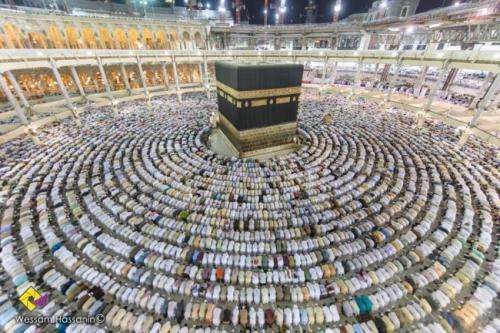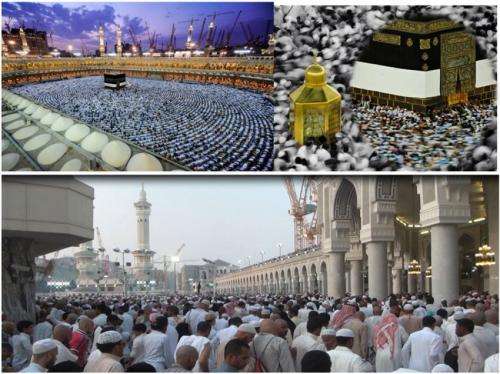During prayer in Holy Mosque at the Hajj, 2012. Credit: Wessam Hassanin.
(Phys.org) —A pair of researchers has found that if people in a large crowd identify socially with other members, they tend to feel safe, even as the density goes up. Hani Alnabulsia and John Drury of the University of Sussex, and Umm Al-Qura University respectively conducted a survey of people attending the annual Hajj in Mecca in 2012 regarding their feelings of safety, and also counted members in the crowd to establish density—they've published their results in Proceedings of the National Academy of Sciences.
Crowds can be dangerous places, examples of what can happen appear regularly in the news—from trampling to suffocation to violence, masses of people often spell trouble. For these reasons, many people find themselves feeling scared when in a crowd—particularly when suddenly noticing that their fate is no longer in their own hands. But, as Alnabulsia and Drury note in their paper, that may not always be the case.
One of the danger elements in crowds is perception of fear. If the people in the crowd are afraid something bad is going to happen, they might take actions that wind up causing it to happen. In this new study, the research duo sought to find out if it might be possible in some instances, to feel perfectly safe, despite being in the midst of a horde of other people. To find out, they spoke to 1,194 pilgrims at the Hajj in Mecca in 2012, site of one the largest annual gatherings of people in the world—attendance is close to three million people each year. The researchers also noted crowd density as it applied to those being queried about their feelings regarding their safety—they found at times it approached 8 people per square meter, which is of course, quite packed.
In analyzing their findings, the researchers found that many of those attending the Hajj reported little concern about their safety, regardless of the density of the crowd. When asked why, the most widely reported answer was because they felt that others in the crowd were supportive. Notably, those that reported the highest levels of social identification also reported the highest levels of feeling safe.
Ka’aba and Holy Mosque at the Hajj, 2012. Credit: Image courtesy of Wessam Hassanin
Of course, feeling safe and actually being safe are two very different things. This new study doesn't prove that supportive crowds actually are safer, just that the people in them feel so. More study will have to be done to determine if supportive crowds actually are safer, backing up those feelings.
More information: Hani Alnabulsi and John Drury. "Social identification moderates the effect of crowd density on safety at the Hajj." PNAS 2014 ; published ahead of print June 9, 2014, DOI: 10.1073/pnas.1404953111
Abstract
Crowd safety is a major concern for those attending and managing mass gatherings, such as the annual Hajj or pilgrimage to Mecca (also called Makkah). One threat to crowd safety at such events is crowd density. However, recent research also suggests that psychological membership of crowds can have positive benefits. We tested the hypothesis that the effect of density on safety might vary depending on whether there is shared social identification in the crowd. We surveyed 1,194 pilgrims at the Holy Mosque, Mecca, during the 2012 Hajj. Analysis of the data showed that the negative effect of crowd density on reported safety was moderated by social identification with the crowd. Whereas low identifiers reported reduced safety with greater crowd density, high identifiers reported increased safety with greater crowd density. Mediation analysis suggested that a reason for these moderation effects was the perception that other crowd members were supportive. Differences in reported safety across national groups (Arab countries and Iran compared with the rest) were also explicable in terms of crowd identification and perceived support. These findings support a social identity account of crowd behavior and offer a novel perspective on crowd safety management.
Journal information: Proceedings of the National Academy of Sciences
© 2014 Phys.org






















